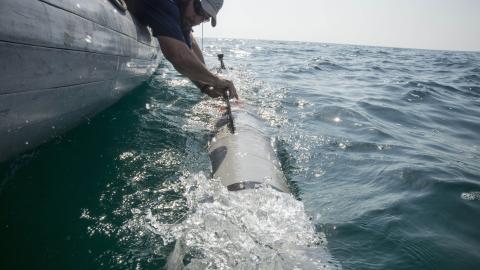During the Naval Submarine League’s annual symposium last month, senior US officers issued dire warnings about the state of their force. It is buckling under costs for the new Columbia-class missile submarine and hobbled by construction and maintenance delays that shrink the number of boats able to deploy. But a more significant challenge looms for the US submarine fleet. After decades of owning the undersea, it faces Chinese and Russian capabilities that could neutralize America’s submarine advantage and threaten the United States and its allies at sea and ashore.
Russia, with its Poseidon nuclear-armed underwater drone and small fleet of quiet submarines, may be a more acute menace to the US homeland, but China’s growing submarine force and undersea sensors and weapons could change the global balance of power. By preventing US submarines from operating effectively within the East China Sea and South China Sea and imperiling carriers and air bases across the Western Pacific, China’s undersea forces could make allies such as Taiwan and Japan reconsider their reliance on US protection.
China's military recognized more than a decade ago that one of its biggest weaknesses was anti-submarine warfare, or ASW. US submarines could wreak havoc on ships defending or carrying People’s Liberation Army troops, undermining Chinese leaders' ability to use the threat of invasion to coerce Taiwan into obedience. US ASW capabilities were also considered the best in the world and could easily track and counter China’s relatively noisy submarines.
China's multidimensional effort to counter US submarines is now bearing fruit. Research institutions controlled by Beijing operate undersea observatories across the South and East China seas. Although their passive sonars may not be able to hear quiet US submarines, these observatories could detect missile and torpedo launches or unmanned vehicle deployment. China has also deployed sophisticated acoustic arrays between the US submarine base in Guam and the Philippines that can hear faint noises hundreds of miles away.
The PLA complements its fixed sonar arrays with a growing fleet of ASW ships and aircraft. Whereas passive arrays on the seafloor could be defeated by US sound silencing efforts, the low-frequency active sonars towed by Chinese corvettes and helicopters could detect even the quietest US submarines at ranges of 100 miles or more. With more than 70 corvettes in service, China’s navy could cover significant portions of the South and East China seas.
In contrast to the US ASW approach, which methodically targets enemy submarines using aircraft, ships, and submarines until a torpedo attack is likely to succeed, the PLA appears to be planning reactive engagements against possible detections of US boats. China’s military is incorporating torpedo warheads into anti-ship missiles, which would allow a variety of ships and shore-based launchers to attack submarines up to 100 miles away. At longer ranges, the PLA’s fleet of Y-8X maritime patrol aircraft, which is too small to sustain searches, seems designed to investigate and attack submarine detections by fixed arrays or ship-borne sonars. And the PLA has built thousands of anti-submarine mines that could be placed in chokepoints where US submarines are likely to go.
Once attacked by a missile or aircraft, US submarine commanders will either need to continue their missions knowing they have been detected or break off and attempt to regain their stealth. Because submarines are important to US war plans, commanders may be unable to accept the risk of being damaged or destroyed by sustained PLA attacks. As a result, the PLA ASW approach, while inefficient, could suppress US submarine operations in a manner similar to the Allied effort against Germany during the Battle of the Atlantic.
The situation is not any better for the US Navy on defense. Although China’s submarine fleet is not as silent or sophisticated as Russia’s, the PLA’s growing force of modern air-independent submarines, such as the Yuan, can be very quiet for weeks at a time. In advance of a military confrontation, the Chinese navy could deploy most of its approximately two-dozen Yuans, overwhelming the US Navy’s fleet of P-8A Poseidon maritime patrol aircraft at chokepoints like the Ryukyu or Luzon Straits.
Unable to attack the subs preemptively and facing potential air threats from China, the P-8As would eventually have to let some or all the Yuans pass. US destroyers and submarines, which would normally back up P-8As by trailing enemy submarines, would likely have other taskings to deter or prepare for conflict with China. Free of US ASW operations, Chinese submarines such as the Yuan could execute lethal attacks on US ships or shore installations using cruise missiles that can reach nearly 200 miles or shorter-range torpedoes.
The US Navy cannot address China’s undersea challenges by simply growing the submarine fleet. The industrial base cannot accelerate production, in part because of workforce constraints. Moreover, as numerous naval leaders have noted , the US military does not have time to build its way back to undersea superiority before China can act against Taiwan.
Unmanned systems, however, could enable the navy to help US submarines defeat enemy undersea defenses, similar to how jammers and decoys can suppress opposing air defenses. To detect China’s expanding force of quiet submarines at scale and without risking P-8As, the US Navy could use relocatable seabed sonars at chokepoints, complemented by unmanned aircraft deploying sonobuoys. Once detected, unmanned surface vessels with towed arrays could track and trail enemy submarines until they could be engaged by US ships or aircraft.
China poses a rising threat to the United States and its allies. To sustain its ability to help deter and counter Beijing’s coercion and aggression, the US Navy will need to expand its undersea fleet beyond submarines and embrace unmanned systems. Otherwise, the US submarine force could remain the world’s best while becoming increasingly irrelevant to America’s military strategy.


















